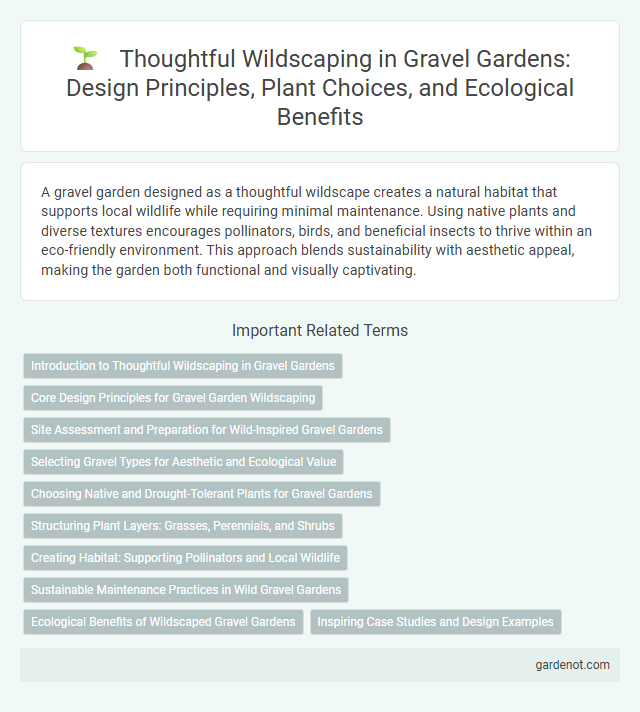A gravel garden designed as a thoughtful wildscape creates a natural habitat that supports local wildlife while requiring minimal maintenance. Using native plants and diverse textures encourages pollinators, birds, and beneficial insects to thrive within an eco-friendly environment. This approach blends sustainability with aesthetic appeal, making the garden both functional and visually captivating.
Introduction to Thoughtful Wildscaping in Gravel Gardens
Thoughtful wildscaping in gravel gardens enhances biodiversity by integrating native plants that support local wildlife while maintaining low water use and soil erosion control. Strategic placement of drought-tolerant species like sedums, lavender, and ornamental grasses creates natural habitats within the gravel matrix, promoting pollinators and beneficial insects. This sustainable approach balances aesthetic appeal with ecological function, transforming gravel gardens into vibrant, resilient ecosystems.
Core Design Principles for Gravel Garden Wildscaping
Gravel garden wildscaping emphasizes core design principles such as water efficiency, native plant selection, and habitat creation to foster a sustainable ecosystem. Incorporating diverse textures and layered planting supports pollinators and enhances biodiversity while minimizing maintenance. Strategic placement of gravel also improves drainage and soil health, making it an eco-friendly landscaping choice.
Site Assessment and Preparation for Wild-Inspired Gravel Gardens
Site assessment for wild-inspired gravel gardens involves analyzing soil composition, drainage patterns, sunlight exposure, and existing vegetation to create a thriving, low-maintenance wildscape. Proper preparation includes amending soil with organic matter, ensuring adequate gravel depth, and selecting drought-tolerant, native plants that complement the site's microclimate. This approach promotes biodiversity, conserves water, and enhances ecological resilience within the gravel garden design.
Selecting Gravel Types for Aesthetic and Ecological Value
Selecting gravel types for a gravel garden enhances both aesthetic appeal and ecological value by choosing materials that support native flora and fauna. Crushed granite, limestone, and quartz gravel offer diverse textures and colors that complement plantings while promoting proper drainage and soil health. Incorporating locally sourced gravel reduces environmental impact and encourages biodiversity by providing habitats for beneficial insects and microorganisms.
Choosing Native and Drought-Tolerant Plants for Gravel Gardens
Choosing native and drought-tolerant plants for gravel gardens enhances sustainability by reducing water usage and maintenance needs. Species such as lavender, sedum, and ornamental grasses thrive in well-drained gravel beds while supporting local wildlife and pollinators. Incorporating these resilient plants creates a balanced wildscape that adapts naturally to regional climates and soil conditions.
Structuring Plant Layers: Grasses, Perennials, and Shrubs
Structuring plant layers in a gravel garden with a thoughtful wildscape approach enhances biodiversity and visual interest through the strategic placement of grasses, perennials, and shrubs. Grasses provide movement and texture, perennials add seasonal color and attract pollinators, while shrubs offer height and shelter for wildlife. Combining these plant types creates a dynamic, sustainable ecosystem that thrives in well-drained, nutrient-poor gravel soils.
Creating Habitat: Supporting Pollinators and Local Wildlife
Designing a gravel garden with native plants and diverse flowering species creates essential habitats for pollinators like bees, butterflies, and hummingbirds. Incorporating layers of vegetation and natural debris provides shelter and nesting sites for local wildlife, enhancing biodiversity. Maintaining seasonal blooms and avoiding pesticides supports healthy ecosystems and sustainable habitats in urban and rural areas.
Sustainable Maintenance Practices in Wild Gravel Gardens
Sustainable maintenance practices in wild gravel gardens prioritize minimal water use and natural soil enhancement through mulching and organic composting, promoting biodiversity and resilience. Integrating native drought-tolerant plants reduces the need for fertilizers and pesticides, supporting ecological balance within the gravel matrix. Regularly monitoring plant health and encouraging natural pollinators ensures ongoing ecosystem vitality while minimizing environmental impact.
Ecological Benefits of Wildscaped Gravel Gardens
Wildscaped gravel gardens enhance biodiversity by providing habitat and food sources for pollinators such as bees, butterflies, and beneficial insects. These gardens improve soil health and water retention, reducing erosion and supporting local ecosystems. By promoting native plant growth, wildscaped gravel gardens contribute to a balanced ecosystem while requiring minimal maintenance and irrigation.
Inspiring Case Studies and Design Examples
Gravel gardens transform urban spaces by combining low-maintenance surfaces with native plants, enhancing biodiversity and visual appeal. Inspiring case studies showcase how designers integrate drought-tolerant species with gravel to create sustainable, ecological habitats that support pollinators and improve soil health. These design examples emphasize the synergy between aesthetic gravel layouts and functional wildscape features, promoting resilience and environmental stewardship.
Thoughtful wildscape Infographic

 gardenot.com
gardenot.com